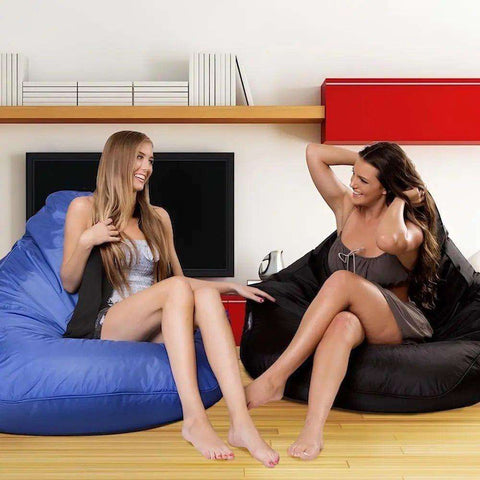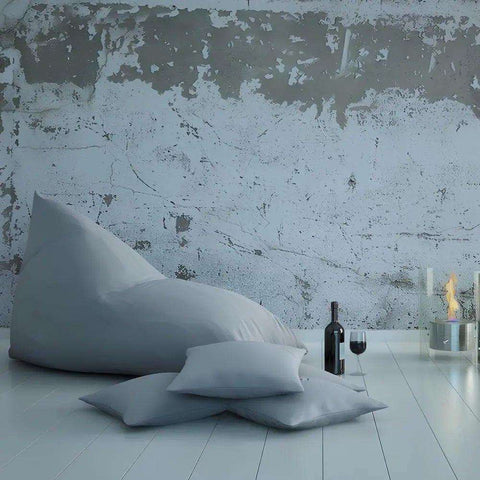They may seem expensive, but when you consider their quality, they actually represent extraordinary value.
Regular three-piece suites are famously expensive. The cost of upholstery, carefully crafted wooden frames, cushions, labor, and transport all add up. So why are traditional furniture pieces so expensive?
Not everyone wants to spend thousands on fancy seating. Sometimes, you just want something simple and affordable. You might think bean bags are much cheaper than regular sofas because they look easier to make. But when you shop for beautiful bean bags, you might be surprised by the price. Many people wonder why are bean bags expensive when they appear so simple.
Many of the costs involved in making regular sofas also apply to bean bags. It’s not just about stuffing a sack with foam and selling it. The cost of labor, development, and materials adds up. While bean bags are usually less expensive than traditional seating, they can still be a significant investment. The higher price of quality bean bags is often due to premium materials and skilled craftsmanship.
Why Are Bean Bags So Expensive?
People often think bean bags should be cheap because they’re soft and flexible. But making a quality bean bag takes craftsmanship and innovation, just like regular furniture. Designer bean bags are much more than a simple sack filled with polystyrene. A premium bean bag chair is crafted with high-quality materials, durable stitching, and thoughtful design to ensure lasting comfort and support. They often have multiple sections to keep the filling in place and provide real support. Ergonomic support is also a key feature in quality bean bags, helping to promote better posture and reduce back pain.
The price of a bean bag reflects the value it offers. A good bean bag is defined by its comfort, durability, and the ergonomic support it provides, making it a worthwhile investment. Let’s look at what goes into making a bean bag and why the cost is what it is.
If you have ever considered buying a bean bag, think about the materials, craftsmanship, and ergonomic features that contribute to its overall quality.
The Quality of the Fabrics
We expect to pay $200 for quality shoes or $300 for a leather jacket. But when we see a $500 bean bag, it can be surprising. Much of the cost comes from the quality of the materials. Bean bags need to be made from fabrics that feel good and are strong enough to last. If the fabric is weak, the bean bag can break and spill its filling.
Modern bean bags use a wide range of quality fabrics. For example, Sunbrella is a 100% solution-dyed acrylic that is breathable and resistant to water, mold, mildew, and UV rays. Sunbrella and Olefin are a popular choice for outdoor bean bag covers due to their durability and color retention. Olefin is another synthetic fabric known for its comfort, strength, and colorfastness. Even faux fabrics like faux suede and fur require research and development to make them both comfortable and durable. When comparing nylon vs polyester, it’s also important to consider how well each resists UV rays, mold, mildew, and moisture. Bean bag covers come in a variety of styles, and having removable covers offers convenience for cleaning and maintenance.
There’s a lot of technology and thought that goes into making the outer cover. High-quality covers and outer covers are essential for durability, style, and ease of cleaning, which directly impact the longevity and value of the bean bag. It’s not just about filling a bag with cheap stuffing. The prices of different covers and fabric styles can vary significantly based on the material, features, and whether the cover is removable or designed for specific environments.
The Quantity of Fabric
Bean bags use much more material than a pair of shoes or a jacket. The bigger the bean bag, the more fabric is needed, which increases the price. Sofabeds, couches, and loungers can be huge, often requiring several square meters of fabric to cover all sides.
The more material you need, the more expensive the bean bag will be. The shape of the bean bag also plays a role, as more complex or customized shapes may require additional fabric and can increase the overall cost. Larger bean bags are often the main feature in a room, not just an accessory.
Type of Fabric
The type of fabric used for the cover is a big factor in the price. Here are some common materials:
- Cotton: Cotton is breathable and affordable, but it stains easily and takes a long time to dry. Cotton feels soft and comfortable to sit on, but may lack support compared to a chair.
- Leather: Elegant but very expensive for bean bags. Leather provides a firm and supportive surface to sit on, much like a high-quality chair.
- Silk: Luxurious but usually too expensive for most people. Silk feels smooth and cool to sit on, but is less practical for everyday use.
- Rayon: Used in clothing, but not strong enough for bean bags. Rayon is soft to sit on, but doesn't offer the durability or support needed for frequent sitting.
- Faux leather: Waterproof and flexible, but not very comfortable. Faux leather can feel slick to sit on and may not provide the same comfort as a chair.
- Microsuede: Microsuede is great for, but not for outdoor use. Microsuede is soft and cozy to sit on, offering a comfortable experience similar to a plush chair.
- Nylon: One of the best fabrics for bean bags - strong, affordable, and good for indoor and outdoor use. Nylon is smooth and supportive to sit on, making it a practical alternative to a traditional chair.
- Polyester: Durable, water-resistant, and inexpensive - another top choice for bean bags. Polyester is comfortable to sit on and holds its shape well, providing support like a chair.
Fabric Weight
The best fabrics for bean bags are olefin, solution-dyed acrylic, nylon and polyester, but there are different weights. The density is measured in denier (D). Cheap bean bags are often made with 420D polyester, while quality bean bags use 1680D fibers, which are four times as dense. Heavier fabric costs more but is much more durable, especially for outdoor use and kids’ bean bags.
Amount of Fabric
Larger bean bags need more fabric, which increases the cost. Round bean bags use more fabric than square or rectangular ones because of the way the material is cut. High-quality bean bags often have both an inner and outer cover, adding to the cost. Premium bean bags also use durable liners, which help enhance the longevity and overall quality of the product.
High-Quality, Comfortable, Long-Lasting Fillers
The inside of the bean bag is just as important as the outside. Quality filling makes bean bags comfortable and long-lasting. The best filling is virgin polystyrene, which is fresh from the factory and lasts longer. Polystyrene beads are a popular, budget friendly option for filling a new bean bag chair, as they are lightweight, flexible, and affordable.
Organic fillers like dried beans or rice are available, but they break down over time and may need to be replaced. Some bean bags use memory foam, which is very comfortable and lasts a long time, but it’s more expensive to produce. Bean bags conform to the user's body, providing excellent comfort and support by adapting to the body's shape.
Bean bags are incredibly versatile and can be used as chairs, beds, or couches, making them a versatile choice for various needs.
The Zipper
Quality bean bags have zippers so you can refill or replace the stuffing. Because the filling can be a choking hazard, zippers are made tamperproof for children. In Australia, bean bag zippers must not have a pull tab, as required by law. Manufacturers also reinforce the zipper area with strong materials and double stitching, which adds to the cost.
Designer Finishes
Designer bean bags cost more because of the time and skill needed to create unique finishes. If you want a bean bag with special touches or a unique look, you’ll pay a premium for it - just like with designer clothing.
Protective Coatings
Quality bean bags often have coatings like polyurethane or PVC to protect against moisture, spills, mold, and UV light. These coatings add to the durability and price.
Manufacturing and Distribution Expenses
Manufacturers spend a lot of time improving their products, making bigger and better bean bags. Outdoor bean bags need to withstand sun and rain, which requires better materials and technology. Shipping bean bags is also expensive because they take up a lot of space. Labor costs for cutting, sewing, and stuffing also add up.
Limited Edition Beanbags
Sometimes, bean bags are more expensive because they’re limited edition. These are made in small numbers, often with special materials or designs. Limited edition bean bags are exclusive and sometimes even better value because of their quality.
How Much Do Bean Bags Cost?
Bean bags can cost as little as AUD$15 at department stores or up to USD$1,550 for a luxury model. The price reflects the design, materials, and quality. There is a wide range of bean bag chairs available, with costs influenced by factors such as size, comfort, durability, designer finishes, protective coatings, filling types, and fabric options, especially for outdoor use. While they may seem expensive, they’re usually more affordable than traditional sofas and chairs.
For expert tips on choosing the right style, size, and material, check out our comprehensive Bean Bags Buying Guide.
Bean bag chairs are also a popular choice for relaxing and watching TV, thanks to their comfort and supportive design.
Overall Quality
The quality of a bean bag also affects the price. Handmade bean bags or those made in advanced factories cost more but are usually worth it for the quality. Cheaper bean bags made in low-cost factories may not last as long.
Extra Costs
Other factors can affect the price, like warranties, advertising, and brand reputation. Cheap bean bags may only last a year, while the best bean bags can last five years or more. At Bean Bags R Us, we balance affordability and quality to give you the best value. According to the American Chiropractic Association, ergonomic and supportive furniture is important for maintaining back health, making it essential to choose products that offer both comfort and durability. Our bean bags are chosen for events worldwide because they’re tough and well-priced.





